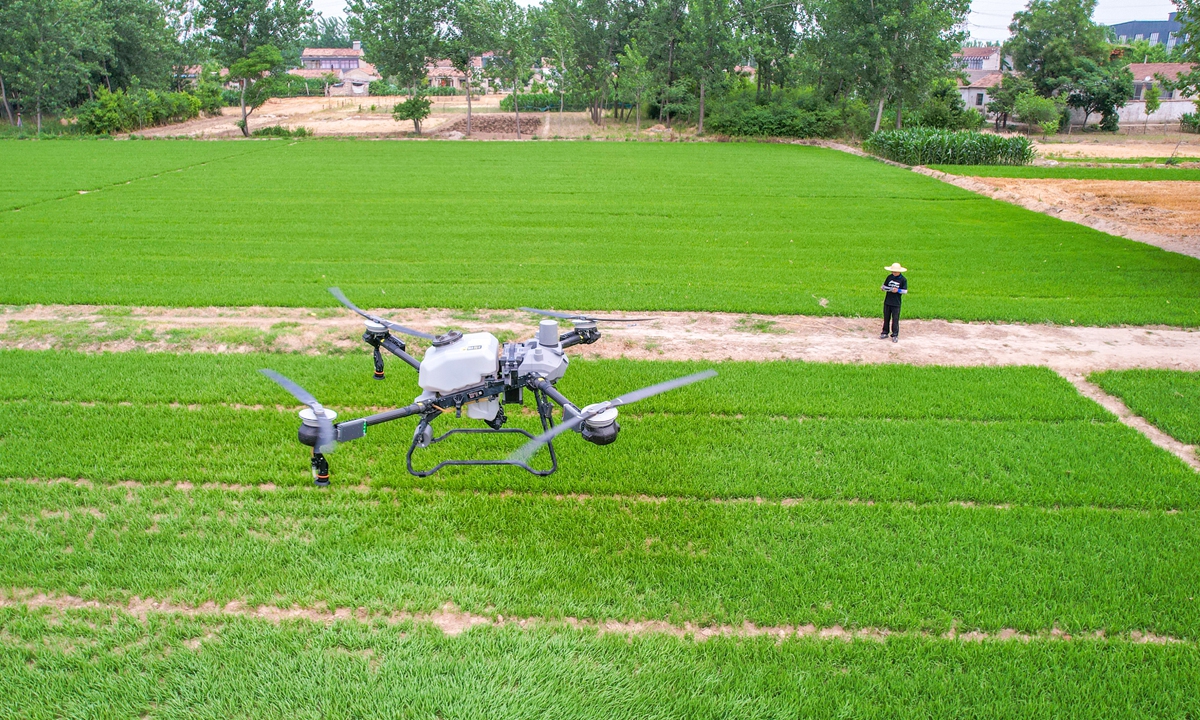
An agriculture drone.
A new absurd "China threat" drama has unfolded on Capitol Hill once again. Recently, a dozen US lawmakers sent a letter to the Biden administration urging it to address "the use of Chinese-manufactured agriculture drones." Their so-called issues include the assumption that these aerosol-dispensing drones might collect and interpret crop data that is "impossible for the human eye to see," potentially gaining access to "technology critical to the success of US agricultural production." The ridiculous ignorance displayed by these lawmakers, who may not have even seen agricultural drones in reality, has once again refreshed the anti-intellectual bottom line of some US politicians.
Such accusations are not worth refuting. In reality, there is significant foundational cooperation between China and the US in agricultural technology. The signing of the US-China Science and Technology Cooperation Agreement was rooted in agricultural technology exchanges. According to Karen Mancl, professor emerita at Ohio State University, since the establishment of diplomatic relations, over 2,100 US agricultural scientists have visited China, and a near equal number of Chinese scientists have toured US farms and laboratories. "This exchange of expertise has helped both countries rise to global food superpowers." During the 2024 US-China Agricultural Roundtable held in June, experts and representatives from both sides also recognized the enormous potential for further cooperation in developing and utilizing advanced agricultural technologies between China and the US.
Agriculture is typically one of the areas least associated with "great power competition." Yet, in recent years, some US lawmakers have been digging "security risks" in this field, claiming that China is buying up US agricultural land, stealing genetically modified seeds from American farms. Now they have even targeted aerosol-dispensing drones. This reflects a lack of substantial material for the "China threat" narrative, leading to a series of farces about Chinese magnets on US fighter jets, cranes at US ports, and drones over US farmland, all exaggerated as "threats."
The underlying truth of these antics is not hard to verify. However, the real danger lies in that the proposed "solutions" by these lawmakers or anti-China advocates invariably involve increasing trade barriers and even extreme "decoupling." People have seen that any field touched by the "China threat" narrative often sees its ordinary practitioners suffering the consequences. A recent article in the US Newsweek, entitled "American Agriculture Can't Afford Another Trade War with China," pointed out that "From 2018 to 2020, American farmers faced devastating losses due to the trade conflict with China," and that "the notion of imposing new tariffs on Chinese goods is perilously misguided."
Previously, the US planned to impose a 25 percent tariff on Chinese-made ship-to-shore cranes, but it encountered strong opposition within the industry. Professional opinions believe that if the US insists on imposing these tariffs, US ports will either have to purchase cranes from China at a higher cost, or resort to buying lower-quality alternatives. It is not difficult to imagine that if agricultural drones are also regarded as a "threat" and exclusionary measures are enacted, the result will be similar: a choice between more expensive and inferior options.
American farmers are gradually and steadily increasing their use of spray drones. In 2023 alone, agricultural spray drones covered an astonishing 3.7 million acres across 41 states and over 50 crops, with most of the drones manufactured in China. If sanctions are imposed on Chinese drones, it is obviously not what American farmers want.
Some people in the US have been "targeting" Chinese drones for some time, yet the demand for Chinese-produced drones in many industries in the US is still strong. Not only that, representatives from over 6,000 public safety agencies - the majority police and fire departments with drone programs - wrote to the Senate Armed Services Committee, urging them not to include the Countering CCP Drones Act in the National Defense Authorization Act. As a result, the relevant restrictions were cancelled. Now some lawmakers are hyping up the "threat" of Chinese-produced agricultural drones, which is nothing more than "old wine in a new bottle." Even if they change the track, the resistance they will encounter will not be small.
China and the US are both major agricultural countries in the world. The global community looks forward to further cooperation between the two countries in addressing climate change, food security, and animal and plant diseases. There are also strong calls for such cooperation within the US. As Professor Mancl said, even today, US and Chinese agricultural scientists are eager to collaborate, and have much to share. "Fifty years of success demonstrates the need for continued agricultural collaboration," she emphasized. Drones have the potential to become a win-win project for China-US agricultural cooperation and should not fall victim to outdated Cold War mentality.




